New Insights into the Medieval Hispano-Muslim Panel Painting: The Alfarje Found in a Balearic Casal (Spain)
Abstract
1. Introduction
2. Results
2.1. Paint Strata Distribution
2.2. Pigments and Other Inorganic Materials Used in the Polychromies
2.2.1. Optical Microscopy
2.2.2. FESEM-EDX, µRaman and FTIR Spectroscopy
2.3. Organic Components
2.3.1. GC-MS
2.3.2. FTIR Spectroscopy
2.3.3. Optical Microscopy
2.3.4. Surface Analysis
2.3.5. Mechanical Properties
3. Discussion
3.1. Materials and Artistic Technique
3.2. Alteration Processes
3.2.1. Pigments and Metal Foils
3.2.2. Binding Media and Varnishes
3.2.3. Biodeterioration
3.2.4. Implications of the Alteration Processes in the Conservation of the Paintings
4. Materials and Methods
4.1. Description of the Polychromies and Sampling Strategy
4.2. Samples Analyzed
4.3. Instrumentation
- Optical microscopy: Stereoscopic microscope Leica GZ6 (X10-X50) and Leica DM2500 P (Leica Microsystems, Heidelberg, Germany) were used for preparing and examining cross-section samples, respectively. IC80HD Leica Digital FireWire Camera (DFC) (Leica Microsystems, Heidelberg, Germany) with Leica Application Suite 4 (LAS) software was used for acquiring and processing the digital images.
- FESEM-EDX: Zeiss model ULTRA 55 (Carl Zeiss AG, Oberkochen, Germany) that operates with an accelerating voltage of 0.8 kV in the electron source and working distance of the detector 2.9–4.0 mm.
- FIB-FESEM-EDX: Zeiss (Carl Zeiss AG, Oberkochen, Germany) model Auriga compact instrument operating at 30 kV and 500 µA. For sectioning samples and forming the trenches the FIB was operated at 20 nA for generating the focused beam of Ga ions. By tilting the stage 54° with the microsample, the Ga beam could be oriented perpendicularly to the plane of the vertical wall of the trench. The secondary and backscattered electron images were acquired at 2 kV in the FESEM. X-ray spot analyses were performed in trenches with an Oxford-X Max X-ray microanalysis system (Oxford Instruments, Abindong, UK) controlled by Aztec software (Oxford Instruments, Abindong, UK). A voltage of 20 kV and a working distance of 6–7 mm was used.
- GC-MS: Agilent 5973N mass spectrometer with an Agilent 6890N gas chromatograph (Agilent Instruments, CA, USA) operated with Agilent Chemstation software (MSD) for the integration of peaks and the evaluation of mass spectra. The chromatographic separation was achieved with a chemically bonded fused-silica capillary column HP-5-MS (Agilent Technologies, CA, USA) (stationary phase 5% phenyle 95% methylpolysiloxane, 30 m, 0.25 mm i.d., 0.25 µm film thickness). Chromatographic conditions: initial temperature 100 °C followed by a gradient of 5 °C min−1 up to 155 °C, ramping up at 15 °C min−1 up to 295 °C, which were held for 5 min. He carrier gas was used with inlet pressure of 99.89 kPa and 1:20 split ratio. Electronic pressure control was set to constant flow mode (1.3 mL min−1) with vacuum compensation. Ions were generated by electron ionization (70 eV) in the ionization chamber of the mass spectrometer, which is scanned in the range m/z 20 to 800, with a cycle time of 1 s.
- FTIR spectroscopy: Vertex 70 Fourier-transform infrared spectrometer (Bruker Optik GmbH 2012, Ettlingen, Germany), equipped with a FR-DTGS (fast recovery deuterated triglycine sulfate) temperature-stabilized coated detector and a MKII Golden Gate Attenuated Total Reflectance (ATR) accessory (Specac Ltd, Orpington, UK). The IR spectra were acquired by collecting 32 scans at a resolution of 4 cm−1. Spectral range scanned was 500–4000 cm−1. The spectra were processed using the OPUS 7.2/IR software (Bruker Optik GmbH 2012, Ettlingen, Germany).
- μRaman spectroscopy: Confocal Raman Microscope Xplora MTB model supplied by Horiba Scientific, Kioto, Japan, that operates with laser beams of 532 nm or 738 nm as excitation source with a maximum power of 90 mW. Other operating conditions were: samples acquired with backscattering geometry at room temperature; microscope objectives x100 and x10 confocal for focusing the excitation laser on the sample and collecting the scattered light to the spectrometer; measurements were performed in 6 different areas per sample to obtain representative results. Exposure time, number of acquisitions, and laser power varied between 10−1 s, 10−5, and 30–80 mW, respectively, and a grating of 1800 groves mm−1 was used in all the measurements. The instrument was controlled with a LabSpect 6 Spectroscopy Suite from Horiba MTB software (Horiba Scientific, Kioto, Japan).
- AFM-NI: The determination of the elastic modulus (EM) was carried out in the microsamples of the original polychromies prepared as cross-sections. A multimode AFM (Digital Instruments VEECO Methodology Group, New York, NY, USA) with a NanoScope IIa controller was used. This instrument is equipped with a J-type scanner with a maximum scan size of (150 × 150 × 6) mm. EM in strata of interest in selected cross-sections was obtained in the ScanAsyst peak-force quantitative nanomechanical mode (QNM) with a tip RTESPA-300 (Bruker Optik GmbH 2012, Ettlingen, Germany) (k = 40 N m−1). Calculation of EM values was carried out with Bruker Nanoscope 1.40 Analysis software. Images created for each paint layer during one scan with scan sizes of (20 × 20) and (40 × 40) µm consisted of 256 lines by pixels and were taken at a scan rate of 0.4–0.5 Hz.
4.4. Reagents
4.5. Preparation of Samples for Analysis
4.6. Processing of Spectra and Topographic Maps
- X-ray spectra acquired with the FESEM-EDX and FIB-FESEM-EDX instruments were processed using the ZAF method. The counting time for acquiring X-ray spectra in quantitative analysis was 100 s. More details relative to the accuracy and repeatability of quantitative measurements in the working conditions can be found in Table S3 provided as supplementary electronic material.
- FTIR spectroscopy: information about the secondary structure of proteinaceous binding media has been obtained in the region of amide I using the Fourier self-deconvolution (FSD) FSD-deconvolution resolution-enhancement technique [47]. Band width and resolution enhancement factor parameters applied in the mathematical process were in the range of 18–19 and 0.65–0.70, respectively. The spectra were processed using the OPUS 7.2/IR software.
- The values of the reduced elastic modulus (Er) were obtained for each pixel by mathematically fitting the retract curve region [107] using the Derjaguin, Muller, Toropov (DMT) model [108], which established the equation:where Ftip and Fadh are the force on the tip and the adhesion force d is the tip-sample separation and R is the radius of the tip end.
5. Conclusions
- The polychromed wooden panels found in the Palma de Mallorca casal are an excellent example of the fusion of cultural influences that took place in the Iberian Peninsula and Balearic Islands. These Hispano-Muslim paintings are made with a ground of gypsum (Ca(SO4)·2H2O) and animal glue and using egg yolk to bind the pigments in the paint layers. The color palette unambiguously identified is composed of white lead (2PbCO3·PB(OH)2), cinnabar (HgS), azurite (Cu3(CO3)2(OH)2), orpiment (As2S3), and indigo (C16H10N2O2).
- Although direct analytical evidence of the use of terpenoid resins, egg yolk, and a drying oil by GC-MS could not be obtained due to the significant transformation of these compounds to oxalate salts, a combination of optical microscopy, FIB-FESEM-EDX and FTIR has provided abundant experimental evidence for sustaining those hypotheses.
- Several alterations have affected and seriously damaged the paintings: fungi growing on the surface in combination with a high humidity level have resulted in the oxidation of metal foils and indigo pigment and the transformation of the organic materials in oxalate salts. This last process affects all the layers of the paintings. Hydrolysis of TAGs and triggering of metal soaps have also been recognized in the paintings. These processes combined have resulted in a loss of the mechanical strength of the paintings.
- The proposed multi-technique approach has proven to be useful in the characterization of the materials, technique, and alterations of the paintings. In particular, a combination of the advanced FIB-FESEM-EDX and AFM-NI, which are scarcely used in the study of cultural heritage, has been successful for performing surface analysis and for the chemical, morphological, and mechanical characterization of the outer part of the paintings.
Supplementary Materials
Author Contributions
Funding
Institutional Review Board Statement
Informed Consent Statement
Data Availability Statement
Acknowledgments
Conflicts of Interest
Sample Availability
References
- Ortega Villoslada, A. El Reino de Mallorca y el Mundo Atlántico (1230–1349): Evolución Político-Mercantil; Universidad Nacional de Educación a Distancia–UNED: La Coruña, Spain, 2008. [Google Scholar]
- Bernabé Pons, L.F. Palma de Mallorca; Asociación de Amigos del Castillo de San Carlos “Aula General Weyler”: Palma de Mallorca, Spain, 2009. [Google Scholar]
- Ladero Quesada, M.A. La Formación Medieval de España; Alianza Editorial: Madrid, Spain, 2014. [Google Scholar]
- Viguera Molins, M.J. El Retroceso Territorial de Al-Ándalus. Almorávides y Almohades, Siglos XI al XIII; Espasa Calpe: Madrid, Spain, 1997. [Google Scholar]
- Fierro, M. The Almohad Revolution. Politics and Religion in the Islamic West During the Twelfth-Thirteenth Centuries; Ashgate: Farnham, UK, 2012. [Google Scholar]
- Feliciano, M.J.; Ruiz Souza, J.C. Al-Andalus and Castile: Art and Identity in the Iberian Peninsula. In Renaissance and Barroque Architecture. Part II. Global Geographies and European Internationalism Ibera, Spanish Italy, the Ottomans, and Latin America; Mallgrave, H.F., Ed.; John Wiley & Sons, Inc.: Hoboken, NJ, USA, 2017. [Google Scholar] [CrossRef]
- Borrás Gualis, G.M. (Ed.) El Arte Mudéjar; Organización de las Naciones Unidas para la Educación, la Ciencia y la Cultura, UNESCO: Washington, DC, USA, 1996. [Google Scholar]
- Borrás Gualis, G.M. El mudéjar, un arte español. Trébede Mens. Aragon. Anál. Opin. Cult. 2002, 62, 14–17. [Google Scholar]
- Torres Balbás, L. El más antiguo alfarje conservado en España. Al-Ándalus 1944, 9, 441–448. [Google Scholar]
- López Pertíñez, M.C. La Carpintería en la Arquitectura Nazarí; Junta de Andalucía. Consejería de Cultura. Patronato de la Alhambra y Generalife: Granada, Spain, 2018. [Google Scholar]
- García Bueno, A. La policromía en la carpintería nazarí. In La Carpintería en la Arquitectura Nazarí; Carmen López Pertíñez, M., Ed.; Junta de Andalucía. Consejería de Cultura. Patronato de la Alhambra y Generalife: Granada, Spain, 2018; pp. 70–89. [Google Scholar]
- Walsh-Korb, Z.; Avérous, L. Recent developments in the conservation of materials properties of historical wood. Prog. Mat. Sci. 2019, 102, 167–221. [Google Scholar] [CrossRef]
- Hoadley, R.B. Wood as a Physical Surface for Paint Application. In Painted Wood: History and Conservation; Dorge, V., Howlett, F.C., Eds.; The Getty Conservation Institute: Los Angeles, CA, USA, 1998; pp. 2–16. [Google Scholar]
- Mecklenburg, M.F.; Tumosa, C.S.; Erhardt, D. Structural Response of Painted Wood Surfaces to Changes in Ambient Relative Humidity. In Painted Wood: History and Conservation; Dorge, V., Howlett, F.C., Eds.; The Getty Conservation Institute: Los Angeles, CA, USA, 1998; pp. 464–483. [Google Scholar]
- Eastaugh, N.; Walsh, V.; Chaplin, T.; Siddall, R. Pigment Compendium. Optical Microscopy of Historical Pigments; Elsevier-Butterworth-Heinemann: Oxford, UK, 2004. [Google Scholar]
- Feller, R.L. (Ed.) Artists’ Pigments. A Handbook of Their History and Characteristics; Archetype Publications: London, UK, 1986; Volume 1. [Google Scholar]
- Roy, A. (Ed.) Artists’ Pigments. A Handbook of Their History and Characteristics; Oxford University Press: New York, NY, USA, 1993; Volume 2. [Google Scholar]
- West Fitzhugh, E. (Ed.) A Handbook of Their History and Characteristics; Archetype Publications: London, UK, 1997; Volume 3. [Google Scholar]
- García Bueno, A.; Medina Flórez, V.J. The Nasrid plasterwork at “qubba Dar al-Manjara l-kubra” in Granada: Characterisation of materials and techniques. J. Cult. Herit. 2003, 5, 75–89. [Google Scholar] [CrossRef]
- Cardell, C.; Rodríguez-Simón, L.; Guerra, I.; Sanchez-Navas, A. Analysis of Nasrid polychrome carpentry at the hall of the Mexuar Palace, Alhambra complex (Granada, Spain), combining microscopic, chromatographic and spectroscopic methods. Archaeometry 2009, 51, 637–657. [Google Scholar] [CrossRef]
- Llorent-Martínez, E.J.; Domínguez-Vidal, A.; Rubio-Domene, R.; Pascual-Reguera, M.I.; Ruiz-Medina, A.; Ayora-Cañada, M.J. Identification of lipidic binding media in plasterwork decorations from the Alhambra using GC-MS and Cheometrics: Influence of pigments and aging. Microchem. J. 2014, 115, 11–18. [Google Scholar] [CrossRef]
- Arjonilla, P.; Domínguez-Vidal, A.; Correa-Gómez, E.; Rubio-Domene, R.; Lluveras-Tenorio, A.; Ayora-Cañada, M.J.; Colombini, M.P. Characterization of organic materials in the decoration of ornamental structures in the Alhambra monumental ensemble using gas-chromatography/mass spectrometry (GC/MS). Microchem. J. 2018, 140, 14–23. [Google Scholar] [CrossRef]
- Arjonilla, P.; Domínguez-Vidal, A.; Rubio-Domene, R.; Correa-Gómez, E.; de la Torre-López, M.J.; Ayora-Cañada, M.J. Characterization of Wall Paintings of the Harem Court in the Alhambra Monumental Ensemble: Advantages and Limitations of In Situ Analysis. Molecules 2022, 27, 1490. [Google Scholar] [CrossRef]
- Arjonilla, P.; Domínguez-Vidal, A.; Correa-Gómez, E.; Domene-Ruiz, M.J.; Ayora-Cañada, M.J. Raman and Fourier transform infrared microspectroscopies reveal medieval Hispano-Muslim Wood painting techniques and provide new insights into red lead production technology. J. Raman Spectrosc. 2019, 50, 1537–1545. [Google Scholar] [CrossRef]
- Cardell-Fernández, C.; Navarrete-Aguilera, C. Pigment and Plasterwork Analyses of Nasrid Polychromed Lacework Stucco in the Alhambra (Granada, Spain). Stud. Conserv. 2006, 51, 161–176. [Google Scholar] [CrossRef]
- Garrote, M.A.; Robador, M.D.; Pérez-Rodríguez, J.L. Analytical investigation of Mudéjar polychrome on the carpentry in the Casa de Pilatos palace in Sevilla using non-destructive XRF and complementary techniques. Spectrochim. Acta A Mol. 2017, 173, 279–291. [Google Scholar] [CrossRef]
- López Cruz, O.; García-Bueno, A.; Medina Flórez, V.J.; Sánchez Navas, A.; Velilla, N. Pictorials materials used in the polychromic decorations of the facade of the palace of King Pedro I, the royal Alcázar of Seville, Spain. Mater. Construcc. 2015, 65, e054. [Google Scholar] [CrossRef]
- López Cruz, O.; García-Bueno, A.; Medina Flórez, V.J.; Sánchez Navas, A. A methodology for timing interventions made on the polychrome decorations of the façade of the Palace of King Peter I, the Royal Alcázar of Seville, Spain. J. Cult. Herit. 2016, 20, 573–582. [Google Scholar] [CrossRef]
- Calero-Castillo, A.I.; García Bueno, A.; López Cruz, O.; Medina Flórez, V.J. Las yeserías del patio de las Doncellas del Real Alcázar de Sevilla. Avance de resultados de la caracterización de materiales y la técnica. Al-Qantara 2016, 37, 129–141. [Google Scholar] [CrossRef]
- Calero-Castillo, A.I.; García Bueno, A.; López Cruz, O.; Medina Flórez, V.J. La policromía original de las yeserías del Patio de las Doncellas del Real Alcázar de Sevilla. Materiales constitutivos y técnicas de ejecución. Arqueol. Territ. 2017, 24, 255–290. [Google Scholar] [CrossRef]
- Duran-Benito, A.; Herrera-Quintero, L.K.; Tobador-González, M.D.; Pérez-Rodríguez, J.L. Color study of Mudejar paintings of the pond found in the palace of “Reales Alcazares” in Seville. Color Res. App. 2007, 32, 489–495. [Google Scholar] [CrossRef]
- Blasco-López, F.J.; Alejandre, F.J.; Flores-Alés, V.; Cortés, I. Plasterwork in the Ambassadors Hall (Salón de Embajadores) of the Real Alcázar of Seville (Spain): Graphic reconstruction of polychrome work by layer characterization. Constr. Build. Mater. 2016, 107, 332–340. [Google Scholar] [CrossRef]
- Gettens, R.J.; Kühn, H.; Chase, W.T. Lead White. In Artists’ Pigments. A Handbook of Their History and Characteristics; Roy, A., Ed.; Oxford University Press: New York, NY, USA, 1993; Volume 2, pp. 67–82. [Google Scholar]
- Gettens, R.J.; West Fitzhugh, E. Azurite and Blue Verditer. In Artists’ Pigments. A Handbook of Their History and Characteristics; Roy, A., Ed.; Oxford University Press: New York, NY, USA, 1993; Volume 2, pp. 23–36. [Google Scholar]
- Gettens, R.J.; Feller, R.L.; Chase, W.T. Vermilion and Cinnabar. In Artists’ Pigments. A Handbook of Their History and Characteristics; Roy, A., Ed.; Oxford University Press: New York, NY, USA, 1993; Volume 2, pp. 159–182. [Google Scholar]
- Schweppe, H. Indigo and Woad. In Artists’ Pigments. A Handbook of Their History and Characteristics; West Fitzhugh, E., Ed.; Archetype Publications: London, UK, 1997; Volume 3, pp. 81–98. [Google Scholar]
- West Fitzhugh, E. (Ed.) Orpiment and Realgar. In Artists’ Pigments. A Handbook of Their History and Characteristics; Archetype Publications: London, UK, 1997; Volume 3, pp. 47–66. [Google Scholar]
- Gettens, R.J.; Mrose, M.E. Calcium Sulphate Minerals in the Grounds of Italian Paintings. Studies in Conservation. Stud. Conserv. 1954, 1, 174–189. [Google Scholar] [CrossRef]
- Sanjurjo Sánchez, J.; Alves, C.A.S.; Vidal Romaní, J.R.; Fernández Mosquera, D. Origin of Gypsum-rich Coatings on Historic Buildings. Water Air Soil Pollut. 2009, 204, 53–68. [Google Scholar] [CrossRef]
- Lafuente, B.; Downs, R.T.; Yang, H.; Stone, N. The power of databases: The RRUFF project. In Highlights in Mineralogical Crystallography; Armbruster, T., Danisi, R.M., Eds.; W. De Gruyter: Berlin/Heidelberg, Germany, 2015; pp. 1–30. Available online: https://rruff.info (accessed on 20 January 2023).
- Baran, A.; Fiedler, A.; Schulz, H.; Baranska, M. In situ Raman and IR spectroscopic analysis of indigo dye. Anal. Methods 2010, 2, 1372–1376. [Google Scholar] [CrossRef]
- Derrick, M.R.; Stulik, D.; Landry, J.M. Infrarred Spectroscopy in Conservation Science; J. Paul Getty Trust: Los Angeles, CA, USA, 1999. [Google Scholar]
- Mazzeo, R.; Prati, S.; Quaranta, M.; Joseph, E.; Kendix, E.; Galeotti, M. Attenuated total reflection micro FTIR characterisation of pigment–binder interaction in reconstructed paint films. Anal. Bioanal. Chem. 2008, 392, 65–76. [Google Scholar] [CrossRef] [PubMed]
- Izzo, F.C.; Kratter, M.; Nevin, A.; Zendri, E. A Critical Review on the Analysis of Metal Soaps in Oil Paintings. Chem. Open 2021, 10, 904–921. [Google Scholar] [CrossRef] [PubMed]
- Nevin, A.; Melia, J.L.; Osticioli, I.; Gautier, G.; Colombini, M.P. The identification of copper oxalates in a 16th century Cypriot exterior wall painting using micro FTIR, micro Raman spectroscopy and Gas Chromatography-Mass Spectrometry. J. Cult. Herit. 2008, 9, 154–161. [Google Scholar] [CrossRef]
- Salvadó, N.; Butí, S.; Nicholson, J.; Emerich, H.; Labrador, A.; Pradell, T. Identification of reaction compounds in micrometric layers from gothic paintings using combined SR-XRD and SR-FTIR. Talanta 2009, 79, 419–428. [Google Scholar] [CrossRef]
- Byler, D.M.; Susi, H. Examination of the Secondary Structure of Proteins by Deconvolved FTIR Spectra. Biopolymers 1986, 25, 469–487. [Google Scholar] [CrossRef] [PubMed]
- Barth, A. Infrared Spectroscopy of Proteins. Biochim. Biophys. Acta 2007, 1767, 1073–1101. [Google Scholar] [CrossRef] [PubMed]
- Baldassarre, M.; Li, C.; Eremina, N.; Goormaghtigh, E.; Barth, A. Simultaneous Fitting of Absorption Spectra and Their Second Derivatives for an Improved Analysis of Protein Infrared Spectra. Molecules 2015, 20, 12599–12622. [Google Scholar] [CrossRef] [PubMed]
- Jin, Z.; Cui, W.; Zhang, F.; Wang, F.; Cheng, S.; Fu, Y.; Huang, H. Rapid Identification for the Pterocarpus Bracelet by Three-Step Infrared Spectrum Method. Molecules 2022, 27, 4793. [Google Scholar] [CrossRef]
- Pelton, J.T.; McLean, L.R. Spectroscopic Methods for Analysis of Protein Secondary Structure. Ana. Biochem. 2000, 277, 167–176. [Google Scholar] [CrossRef]
- Byler, D.M.; Farrell, H.M., Jr. Infrared Spectroscopic Evidence for Calcium Ion Interaction with Carboxylate Groups of Casein. J. Dairy Sci. 1989, 72, 1719–1723. [Google Scholar] [CrossRef]
- Nara, M.; Morii, H.; Tanokura, M. Infrared spectroscopic study of the metal-coordination structures of calcium-binding proteins. Biochim. Biophys. Acta 2013, 1828, 2319–2327. [Google Scholar] [CrossRef]
- Filopoulou, A.; Vlachou, S.; Boyatzis, S.C. Fatty Acids and Their Metal Salts: A Review of Their Infrared Spectra in Light of Their Presence in Cultural Heritage. Molecules 2021, 26, 6005. [Google Scholar] [CrossRef] [PubMed]
- Hermans, J.J.; Keune, K.; van Loon, A.; Iedema, P.D. An infrared spectroscopic study of the nature of zinc carboxylates in oil paintings. J. Anal. At. Spectrom. 2015, 30, 1600–1608. [Google Scholar] [CrossRef]
- Hermans, J.J.; Keune, K.; van Loon, A.; Corkery, R.W.; Iedema, P.D. Ionomer-like structure in mature oil paint binding media. RSC Adv. 2016, 6, 93363–93369. [Google Scholar] [CrossRef]
- Valido, I.H.; Rius-Bartra, J.M.; Boada, R.; Resina-Gallego, M.; Valiente, M.; López-Mesas, M. Characterization of Calcium Oxalate Hydrates and the Transformation Process. ChemPhysChem 2020, 21, 2583–2593. [Google Scholar] [CrossRef]
- García Esteban, L.; Guindeo Casasús, A. Anatomía e Identificación de las Maderas de Coníferas Españolas; AITIM: Madrid, Spain, 1988. [Google Scholar]
- Medina Flórez, V.J.; García Bueno, A. Metodología en la intervención de las pinturas de Qusayr’ Amra, Jordania. PH. Boletín Inst. Andal. Patrim. Hist. 2022, 39, 59–68. [Google Scholar] [CrossRef]
- De Viguerie, L.; Robador, M.; Castaing, J.; Pérez-Rodríguez, J.L.; Walter, P.; Bouquillon, A. Technological evolution of ceramic glazes in the renaissance: In situ analysis of tiles in the Alcazar (Seville, Spain). J. Am. Ceram. Soc. 2019, 102, 1402–1413. [Google Scholar] [CrossRef]
- Bruquetas, R. Las Técnicas y los Materiales de la Pintura Española de los Siglos de Oro; Fundación de Apoyo a la Historia del Arte Hispánico: Madrid, Spain, 2002; p. 531. [Google Scholar]
- Espejo Arias, T.; López Montes, A.; García Bueno, A.; Durán Benito, A.; Blanc García, R. A Study about Colorants in the Arabic Manuscript Collection of the Sacromonte Abbey, Granada, Spain. A New Methodology for Chemical Analysis. Restaurator 2008, 28, 76–106. [Google Scholar]
- Calvo, A. Materiales, Técnicas y Procedimientos. De la A a la Z; Ediciones del Serbal: Barcelona, Spain, 1997. [Google Scholar]
- Mindata.org. Available online: http://www.mindat.org/loc-290899.html (accessed on 20 January 2023).
- Abdel-Ghani, M. Multidisciplinary study of a Qajar lacquered painting: Technology and materials characterization. Vib. Spectrosc. 2022, 119, 103355. [Google Scholar] [CrossRef]
- Burgio, L.; Clark, R.J.H.; Muralha, V.S.F.; Stanley, T. Pigment analysis by Raman microscopy of the non-figurative illumination in 16th- to 18th-century Islamic manuscripts. J. Raman Spectrosc. 2008, 39, 1482–1493. [Google Scholar] [CrossRef]
- Tanevska, V.; Nastova, I.; Minceva-Sukarova, B.; Grupce, O.; Ozcatal, M.; Kavcic, M.; Jakovlevska-Spirovska, Z. Spectroscopic analysis of pigments and inks in manuscrips: II. Islamic illuminated manuscripts (16th–18th century). Vib. Spectrosc. 2014, 73, 127–137. [Google Scholar] [CrossRef]
- Lazzarini, L.; Schwartzbaum, P.M. The Technical Examination and Restoration of the Paintings of the Al Aqsa Mosque, Jerusalem. Stud. Conserv. 1985, 30, 129–135. [Google Scholar]
- Pérez-Rodríguez, J.L.; Durán, A. Mineralogical Characterization of the Polychrome in Cultural Heritage Artefacts (Antiquity to Date) from Southern Spain Using Micro-Raman Spectroscopy and Complementary Techniques. Spectrosc. Lett. 2014, 47, 223–237. [Google Scholar] [CrossRef]
- Cennini, C. The Book of The Art of: A Contemporary Practical Treatise on Quattrocento Painting; Routledge: Oxfordshire, UK, 2019. [Google Scholar]
- Gayo, M.D.; Jover de Celis, M. The evolution of preparations for painting on canvas in sixteenth and seventeeth century Spain. Boletín Mus. Prado 2010, 28, 39–59. [Google Scholar]
- Masschelein-Kleiner, L. Ancient Binding Media, Varnishes and Adhesives; ICCROM: Rome, Italy, 1995. [Google Scholar]
- Mills, J.S.; White, R. Natural resins of art and archaeology their sources, chemistry and identification. Stud. Conserv. 1977, 22, 12–31. [Google Scholar] [CrossRef]
- García Bueno, A.; Medina Flórez, V.J. La policromía de las yeserías del oratorio de la madraza de Yusuf, I.; Granada. Aportaciones del estudio de materiales en la identificación de zonas originales y añadidos. Al-Qantara 2010, 31, 245–256. [Google Scholar] [CrossRef]
- García Bueno, A.; Medina Flórez, V.J.; González Segura, A. La policromía de los fragmentos de yeso almacenados en los depósitos del museo de la Alhambra. In Proceedings of the 16th International Meeting on Heritage Conservation, Valencia, Spain, 2–4 November 2006; pp. 1601–1614. [Google Scholar]
- Rodríguez-López, A.; Bazeta Gobantes, F. Applied brocade in Spain Origin, making procedures and designs in Northern Spain. Ceroart 2021. [Google Scholar] [CrossRef]
- Thompson, D.V., Jr. The Materials of Medieval Painting; George Allen and Unwin Ltd.: London, UK, 1936. [Google Scholar]
- Graedel, T.E. Corrosion Mechanisms for Silver Exposed to the Atmosphere. J. Electrochem. Soc. 1992, 139, 1963. [Google Scholar] [CrossRef]
- Martinetto, P.; Blanc, B.; Bordet, P.; Champdavoine, S.; Fabre, F.; Guiblain, T.; Hodeau, J.-L.; Lelong, F.; Leynaud, O.; Prat, A.; et al. Non-invasive X-ray investigations of medieval sculptures: New insights on “applied tin-relief brocade” technique. J. Cult. Herit. 2021, 47, 89–99. [Google Scholar] [CrossRef]
- Doménech-Carbó, A.; Doménech-Carbó, M.T.; Osete-Cortina, L.; Donnici, M.; Guasch-Ferré, N.; Gasol-Fargas, R.M.; Iglesias-Campos, M.A. Electrochemical assessment of pigments-binding medium interactions in oil paint deterioration: A case study on indigo and Prussian blue. Herit. Sci. 2020, 8, 71. [Google Scholar] [CrossRef]
- Doménech-carbó, A.; Holmwood, S.; Di Turo, F.; Montoya, N.; Valle-Algarra, F.M.; Edwards, H.G.M.; Doménech-carbó, M.T. Composition and Color of Maya Blue: Reexamination of Literature Data Based On the Dehydroindigo Model. J. Phys. Chem. C. 2019, 123, 770–782. [Google Scholar] [CrossRef]
- Van der Werd, J.; Van Loon, A.; Boon, J.J. FTIR studies of the effects of pigments on the aging of oil. Stud. Conserv. 2005, 50, 3–22. [Google Scholar] [CrossRef]
- Erhardt, D.; Tumosa, C.S.; Mecklenburg, M.F. Long-Term Chemical and Physical Processes in Oil Paint Films. Stud. Conserv. 2005, 50, 143–150. [Google Scholar] [CrossRef]
- Van Loon, V. Color Changes and Chemical Reactivity in Seventeenth-Century Oil Paintings; University of Amsterdam: Amsterdam, The Netherlands, 2008. [Google Scholar]
- Cotte, M.; Checroun, E.; De Nolf, W.; Taniguchi, Y.; De Viguerie, L.; Burghammer, M. Lead soaps in paintings: Friends or foes? Stud. Conserv. 2017, 62, 2–23. [Google Scholar] [CrossRef]
- Robinet, L.; Corbeil, M.C. The Characterization of Metal Soaps. Stud. Conserv. 2003, 48, 23–40. [Google Scholar] [CrossRef]
- Plater, M.J.; De Silva, B.; Gelbrich, T.; Hursthouse, M.B.; Higgitt, C.L.; Saunders, D.R. The characterisation of lead fatty acid soaps in “protrusions” in aged traditional oil paint. Polyhedron 2003, 22, 3171–3179. [Google Scholar] [CrossRef]
- Keune, K. Binding Medium, Pigments and Metal Soaps Characterised and Localised in Paint Cross-Sections. Ph.D. Thesis, University of Amsterdam, Amsterdam, The Netherlands, 2005. [Google Scholar]
- Hermans, J.J. Metal Soaps in Oil Paint: Structure, Mechanisms and Dynamics. Ph.D. Thesis, Universiteit van Amsterdam, Amsterdam, The Netherlands, 2017. [Google Scholar]
- Frank-Kamenetskaya, O.V.; Vlasov, D.Y.; Zelenskaya, M.S.; Knauf, I.V.; Timasheva, M.A. Decaying of the marble and limestone monuments in the urban environment. Case studies from Saint Petersburg, Russia. Stud. UBB Geol. 2009, 54, 17–22. [Google Scholar] [CrossRef]
- Cariati, F.; Rampazzi, L.; Toniolo, L.; Pozzi, A. Calcium oxalate films on Stone surfaces: Experimental assessment of the chemical formation. Stud. Conserv. 2003, 45, 180–188. [Google Scholar] [CrossRef]
- Watchman, A. A review of the history of dating rock varnishes. Earth-Sci. Rev. 2000, 49, 261–277. [Google Scholar] [CrossRef]
- Rampazzi, L.; Andreotti, A.; Bonaduce, I.; Colombini, M.P.; Colombo, C.; Toniolo, L. Analytical investigation of calcium oxalate films on marble monuments. Talanta 2004, 63, 967–977. [Google Scholar] [CrossRef]
- Maravelaki-Kalaitzaki, P. Black crusts and patinas on Pentelic marble from the Parthenon and Erechtheum (Acropolis, Athens): Characterization and origin. Anal. Chim. Acta 2005, 532, 187–198. [Google Scholar] [CrossRef]
- Salvant, J.; Barthel, E.; Menu, M. Nanoindentation and the Micromechanics of Van Gogh Oil Paints. 2011. hal-00593798. Available online: https://hal.archives-ouvertes.fr (accessed on 18 December 2022).
- Fu, Y.; Viraghavan, T. Fungal decolorization of dye wastewaters: A review. Biosour. Technol. 2001, 79, 251–262. [Google Scholar] [CrossRef]
- Sumathi, S.; Manjua, B.S. Uptake of reactive textile dyes by Aspergillus foetidus. Enzym. Microb. Technol. 2000, 27, 347–355. [Google Scholar] [CrossRef] [PubMed]
- Ahlawat, A.; Jaswal, A.S.; Mishra, S. Proposed pathway of degradation of indigo carmine and its co-metabolism by white-rot fungus Cyathus bulleri. Int. Biodeterior. Biodegrad. 2022, 172, 105424. [Google Scholar] [CrossRef]
- Ceballos Enríquez, L. Proyecto COREMANS. Criterios de Intervención en Retablos y Escultura Policromada; Ministerio de Educación, Cultura y Deporte: Madrid, Spain, 2017. [Google Scholar]
- Jabaloyas Garu, J.D. Desmontaje, restauración e instalación de las obras de gran formato de la colección permanente del Museo Arqueológico Nacional. Boletín Mus. Arqueol. Nac. 2015, 33, 7–68. [Google Scholar]
- Gayo, M.D.; Parra, E.; Carrassón, A. Technical examination and consolidation of the Paint layers on a mudéjar coffered ceiling in the Convent of Santa Fe, Toledo. Stud. Conserv. 1992, 37, 54–56. [Google Scholar] [CrossRef]
- Querajatu, P. Conservation and restoration of five coffered ceilings. Stud. Conserv. 1992, 37, 119–121. [Google Scholar] [CrossRef]
- Shtnum, B.; Brussat, M.; García, M.; Hayes, T.; Massaux, S. The Metropolitan Museum of Art’s ‘Spanish Ceiling’ Project: Interpretarion and Conservation. J. Archit. Conserv. 2010, 16, 29–50. [Google Scholar] [CrossRef]
- Vidal, F.; Romeu Vicente, F.; Mendes Silva, J. Review of environmental and air pollution impacts on built heritage: 10 questions on corrosion and soiling effects for urban intervention. J. Cult. Herit. 2019, 37, 273–295. [Google Scholar] [CrossRef]
- Sesana, E.; Gagnon, A.S.; Bonazza, A.; Hughes, J.J. An integrated approach for assessing the vulnerability of World Heritage Sites to climate change impacts. J. Cult. Herit. 2020, 41, 211–224. [Google Scholar] [CrossRef]
- Camuffo, D.; Bertolin, C.; Bonazzi, A.; Campana, F.; Merlo, C. Past, present and future effects of climate change on a wooden inlay bookcase cabinet: A new methodology inspired by the novel European Standard EN 15757:2010. J. Cult. Herit. 2014, 15, 26–35. [Google Scholar] [CrossRef]
- Lee, Y.; Martín-Rey, S.; Osete-Cortina, L.; Martín-Sánchez, I.; Bolívar-Galiano, F.; Doménech-Carbó, M.T. Evaluation of a gelatin-based adhesive for historic paintings that incorporates citronella oil as an eco-friendly biocide. J. Adhes. Sci. Technol. 2018, 32, 2320–2349. [Google Scholar] [CrossRef]
- Derjaguin, B.V.; Muller, V.M.; Toropov, Y.P. Effect of contact deformations on the adhesion of particles. J. Colloid Interface Sci. 1975, 53, 314–326. [Google Scholar] [CrossRef]
- Reed, S.J.B. Electron Microbe Analysis and Scanning Electron Microscopy in Geology; Cambridge University Press: Cambridge, UK, 1996. [Google Scholar]
- Veritá, M.; Basso, R.; Wypyski, M.T.; Koestler, R.J. X-ray microanalysis of ancient glassy materials: A comparative study of wavelength dispersive and energy dispersive techniques. Archaeometry 1994, 36, 241–251. [Google Scholar] [CrossRef]
- Kuisma-Kursula, P. Accuracy, Precision and Detection Limits of SEM–WDS, SEM–EDS and PIXE in the Multi-Elemental Analysis of Medieval Glass. X-Ray Spectrom. 2000, 29, 111–118. [Google Scholar] [CrossRef]
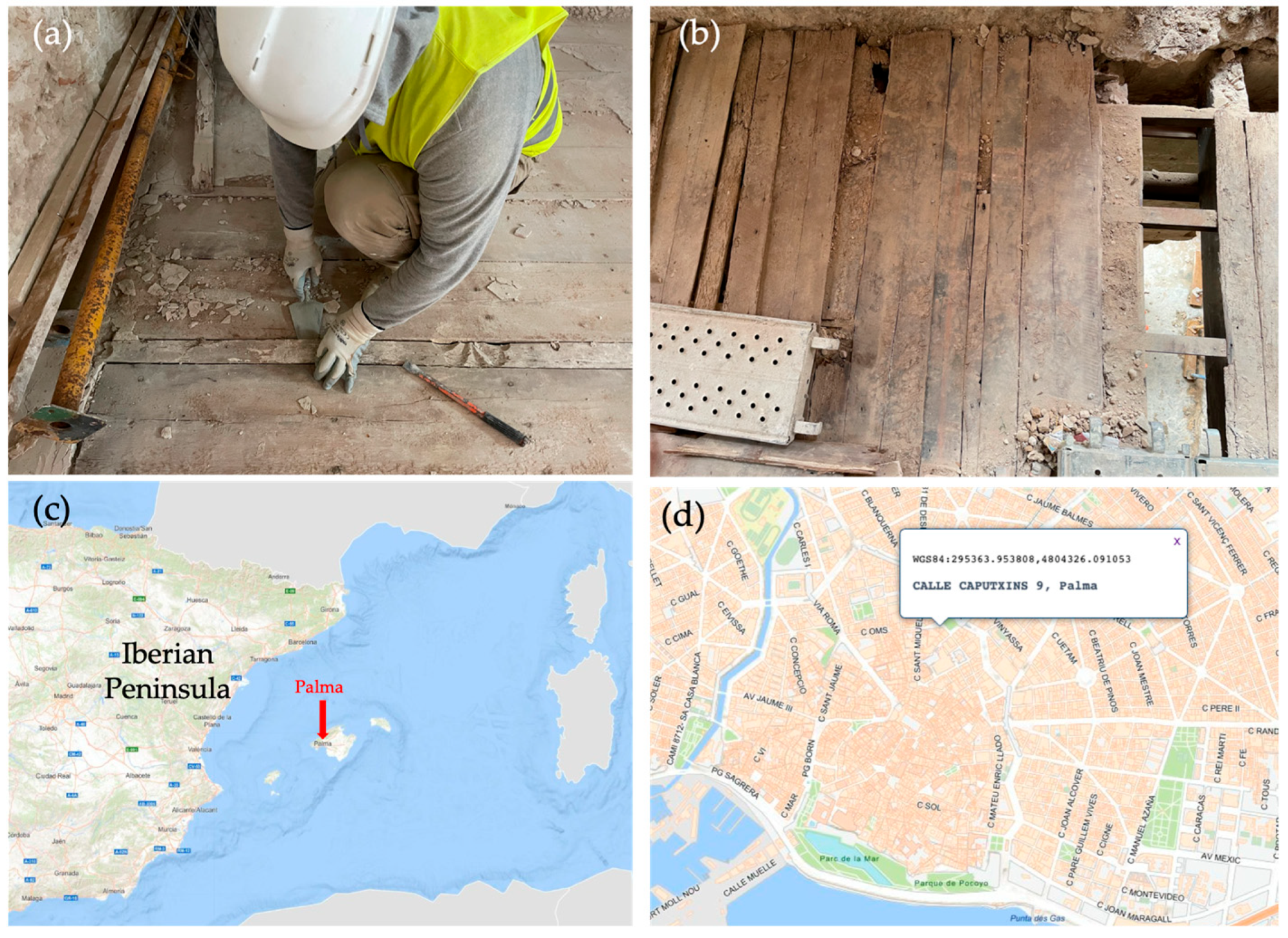
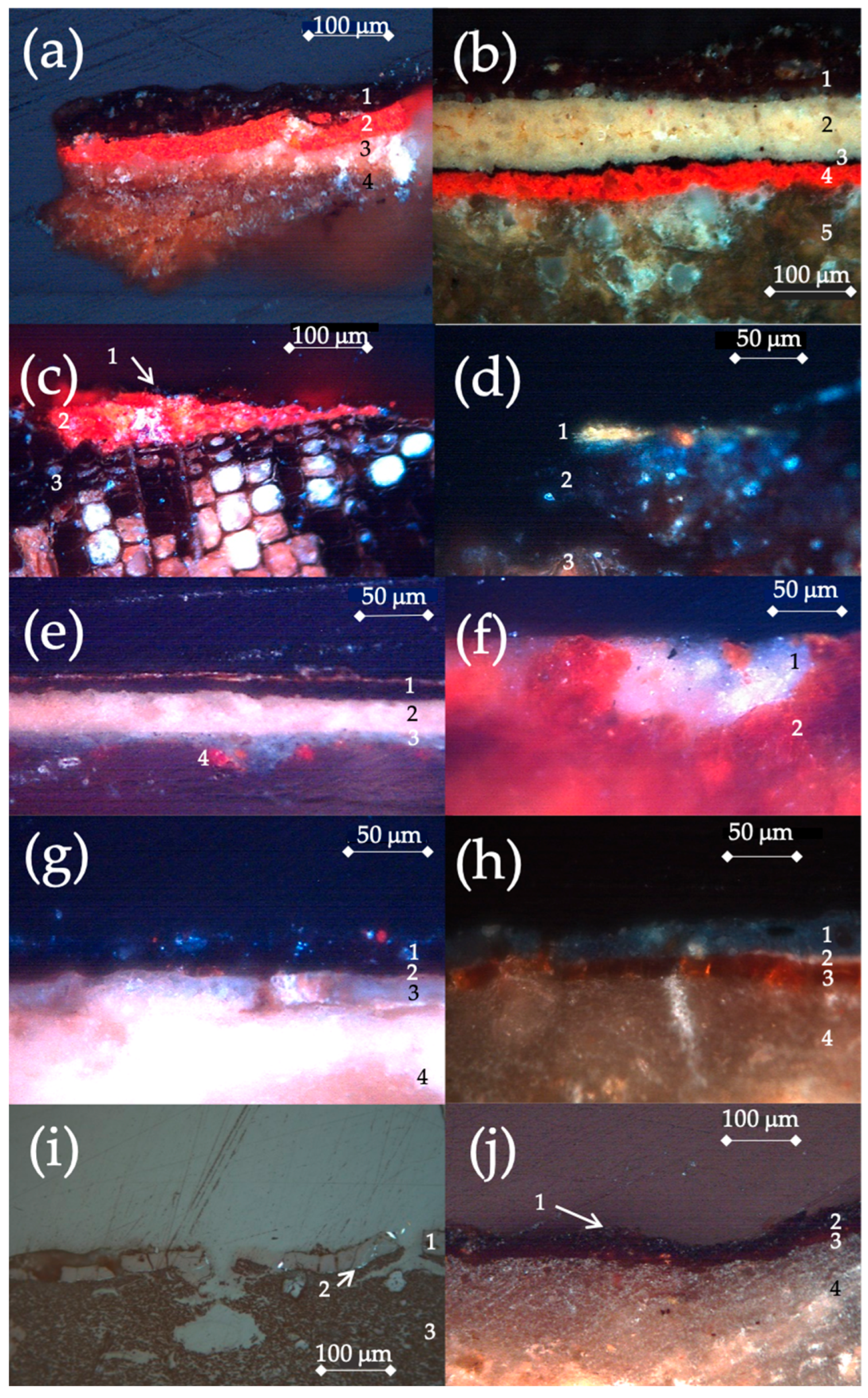
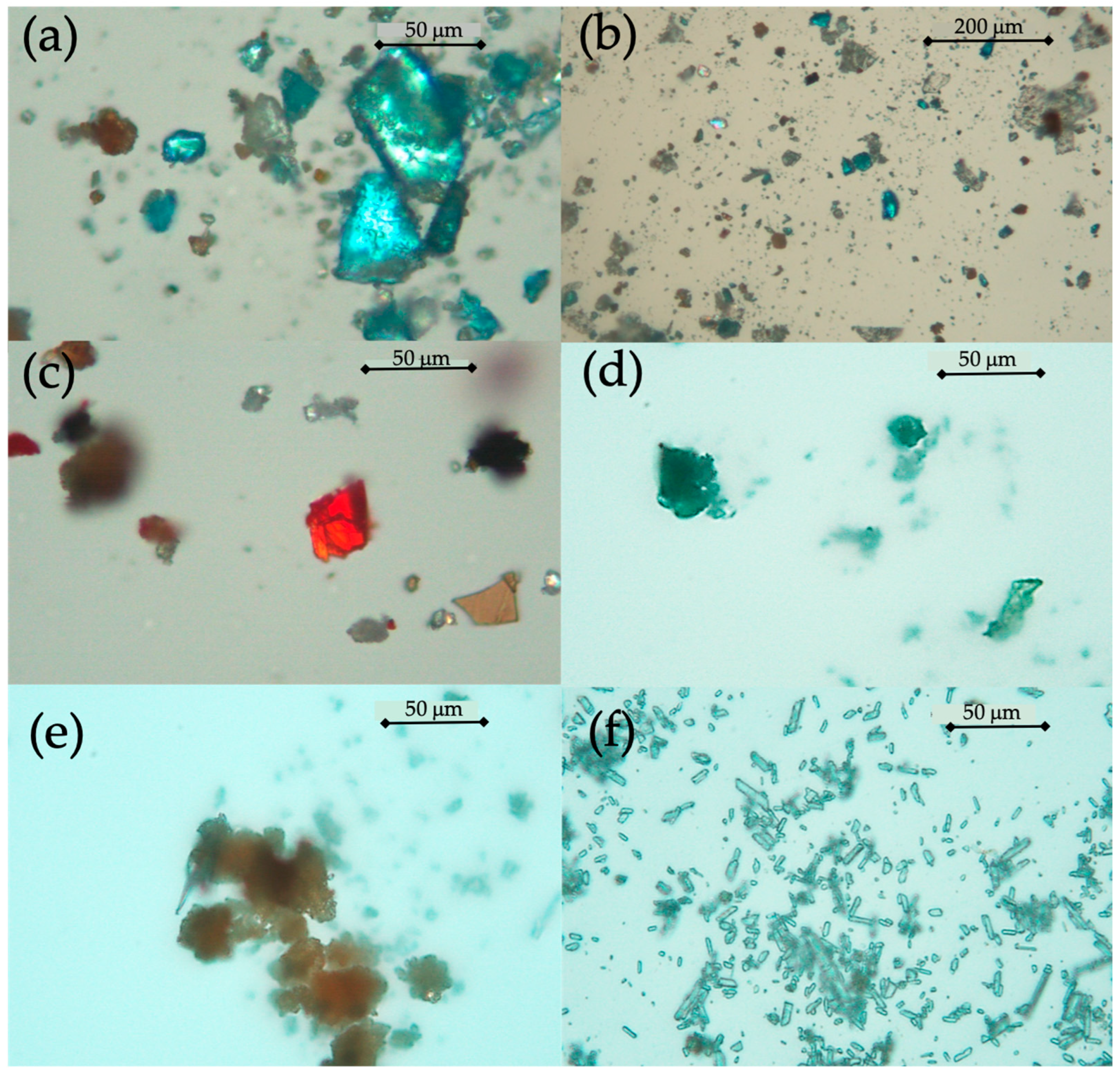
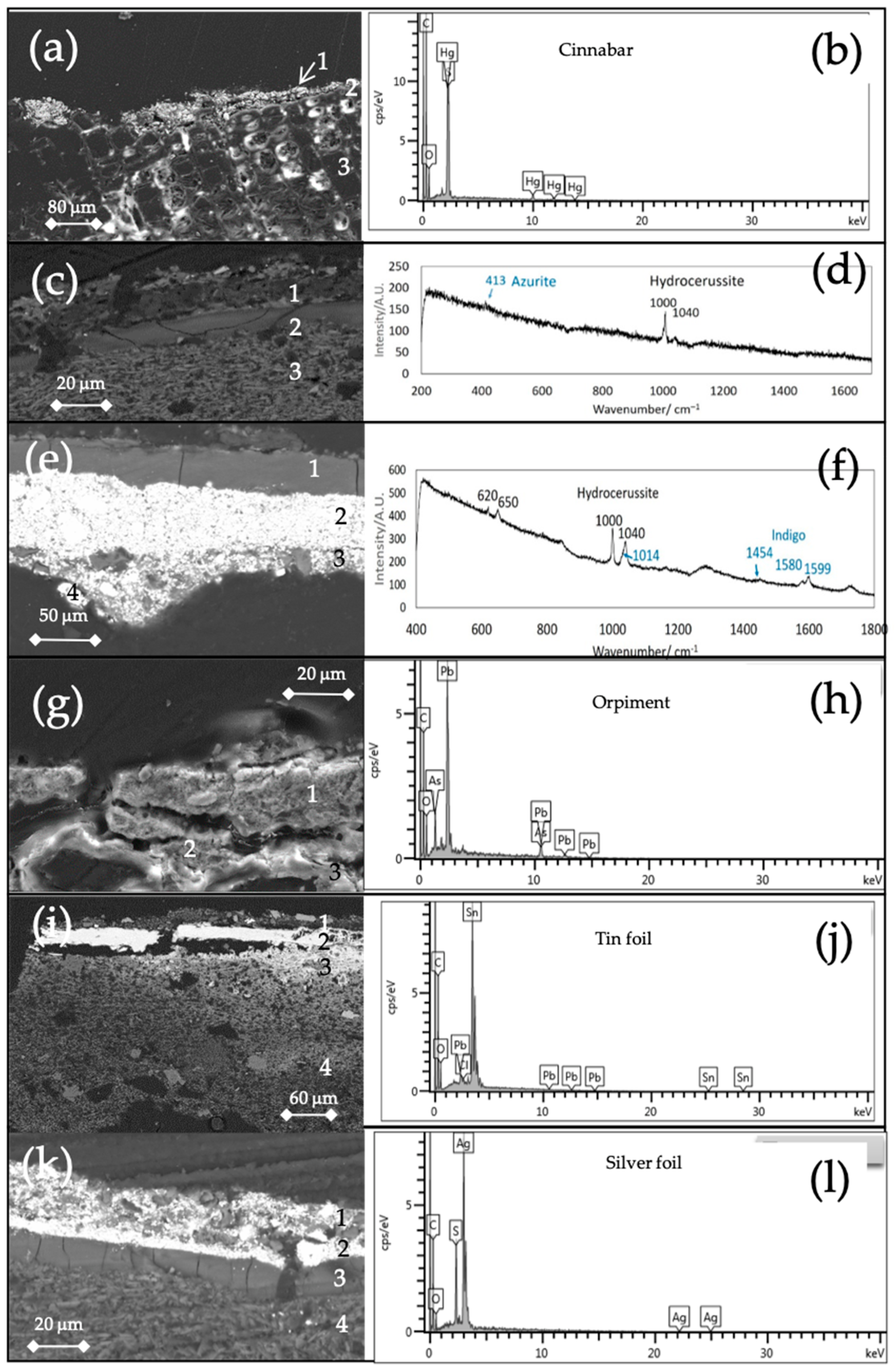



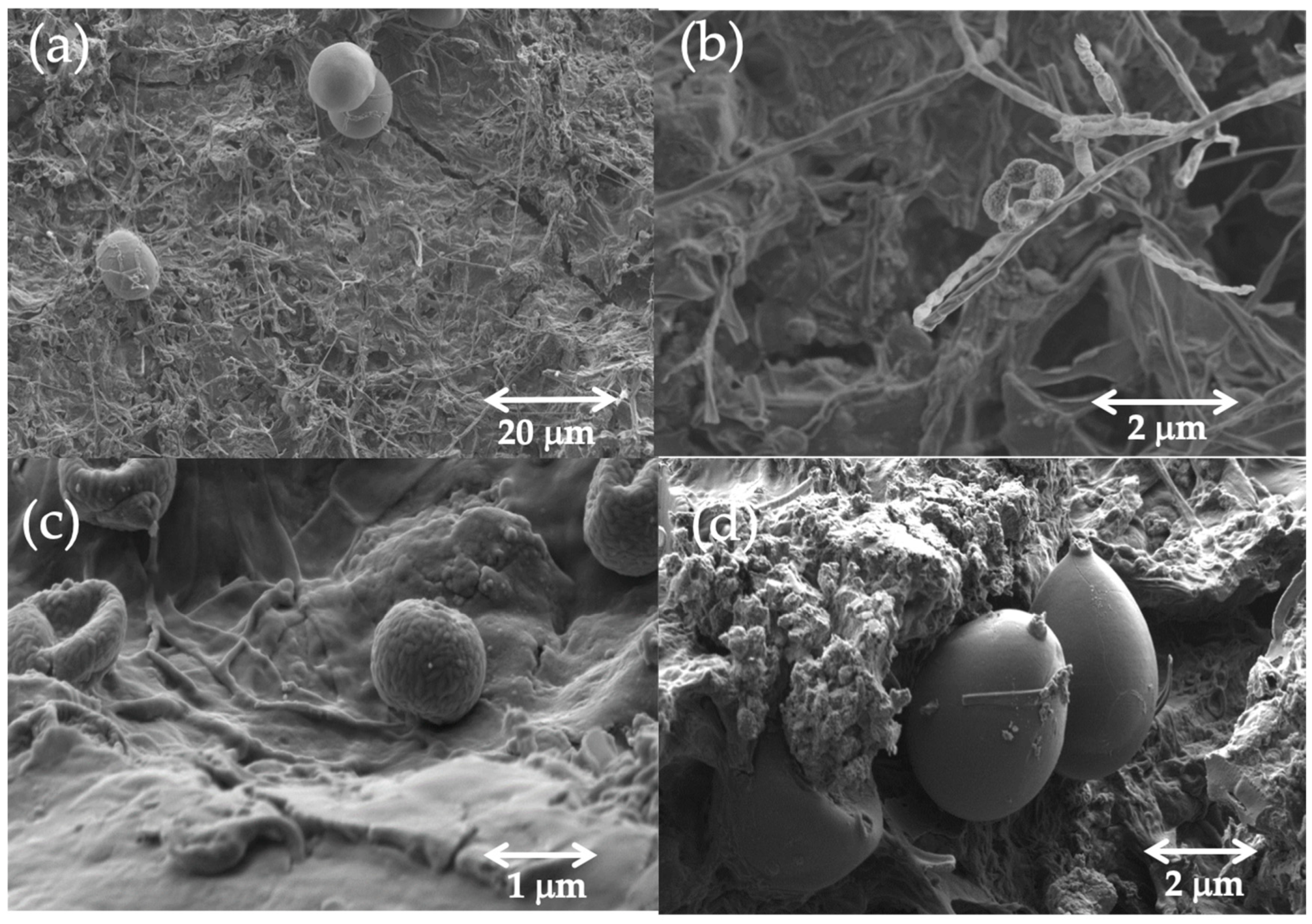

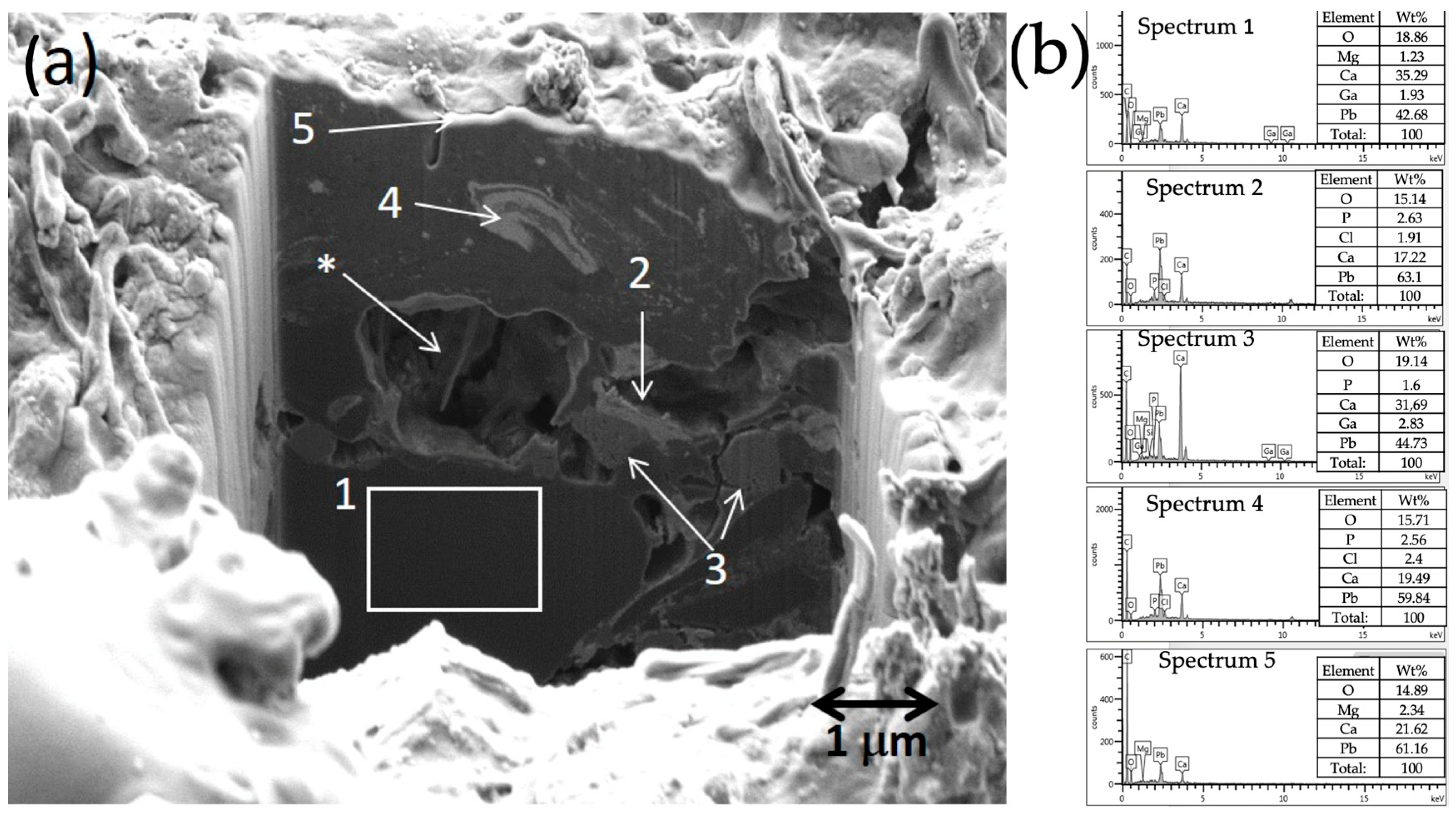
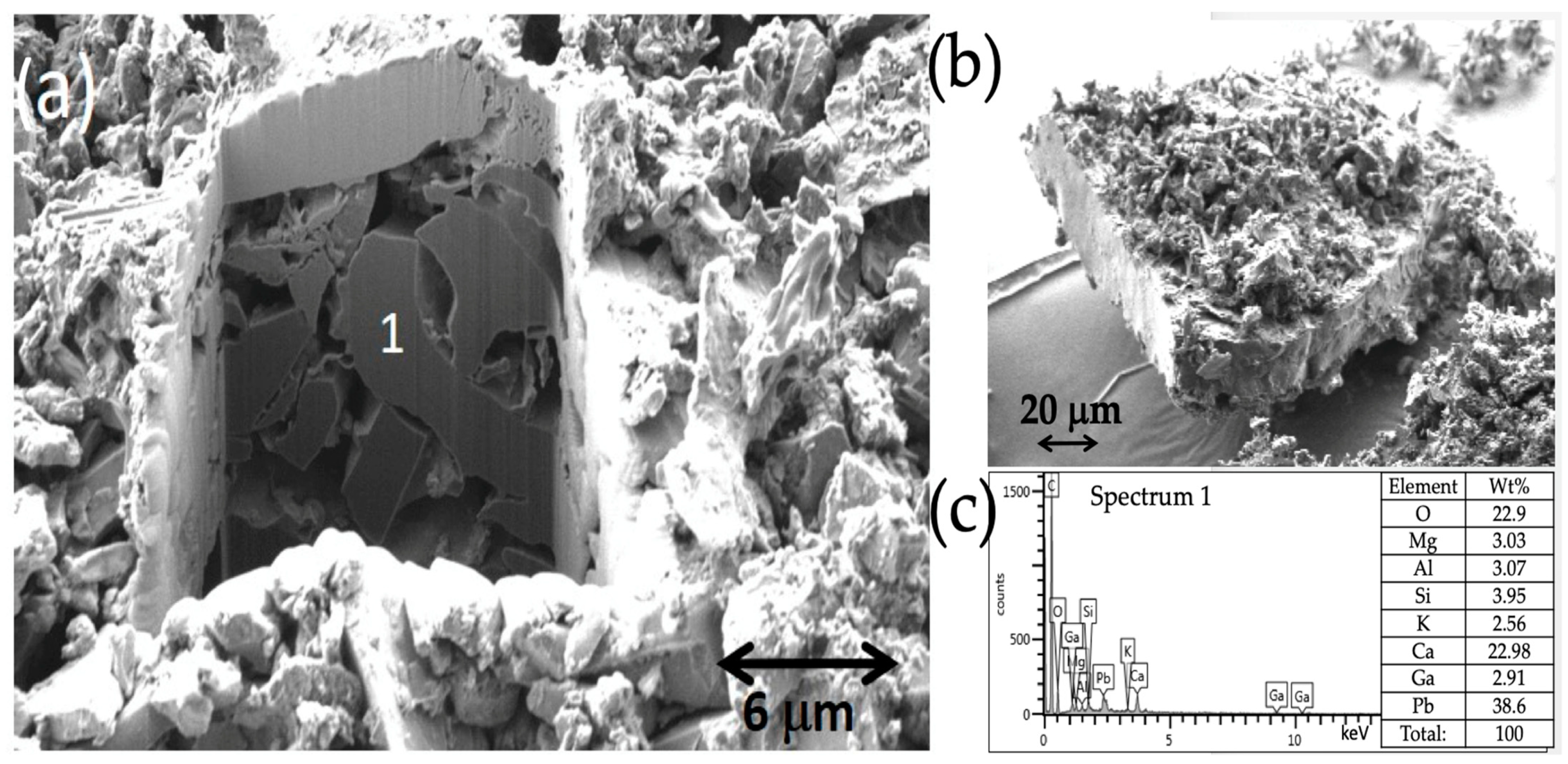

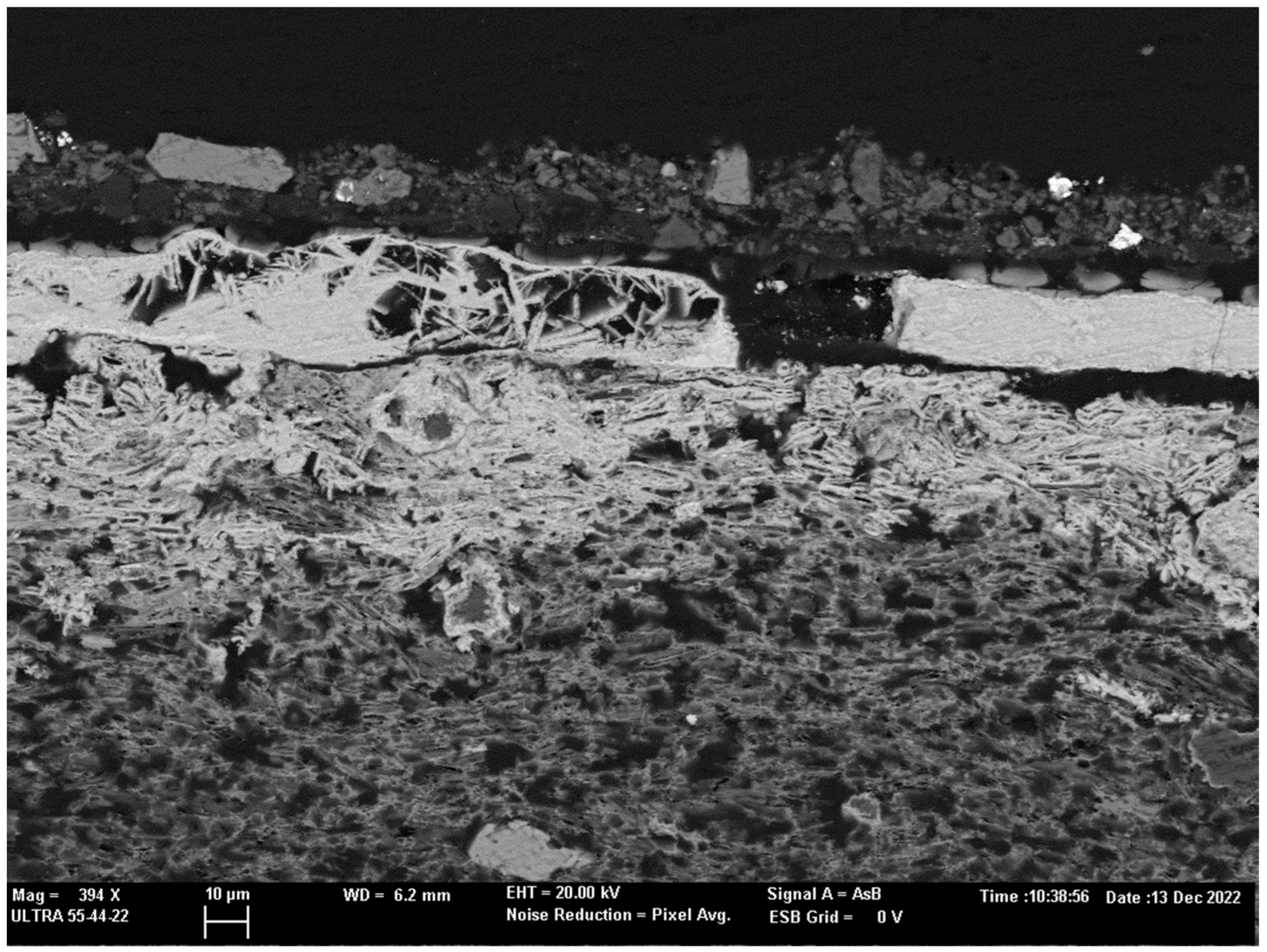

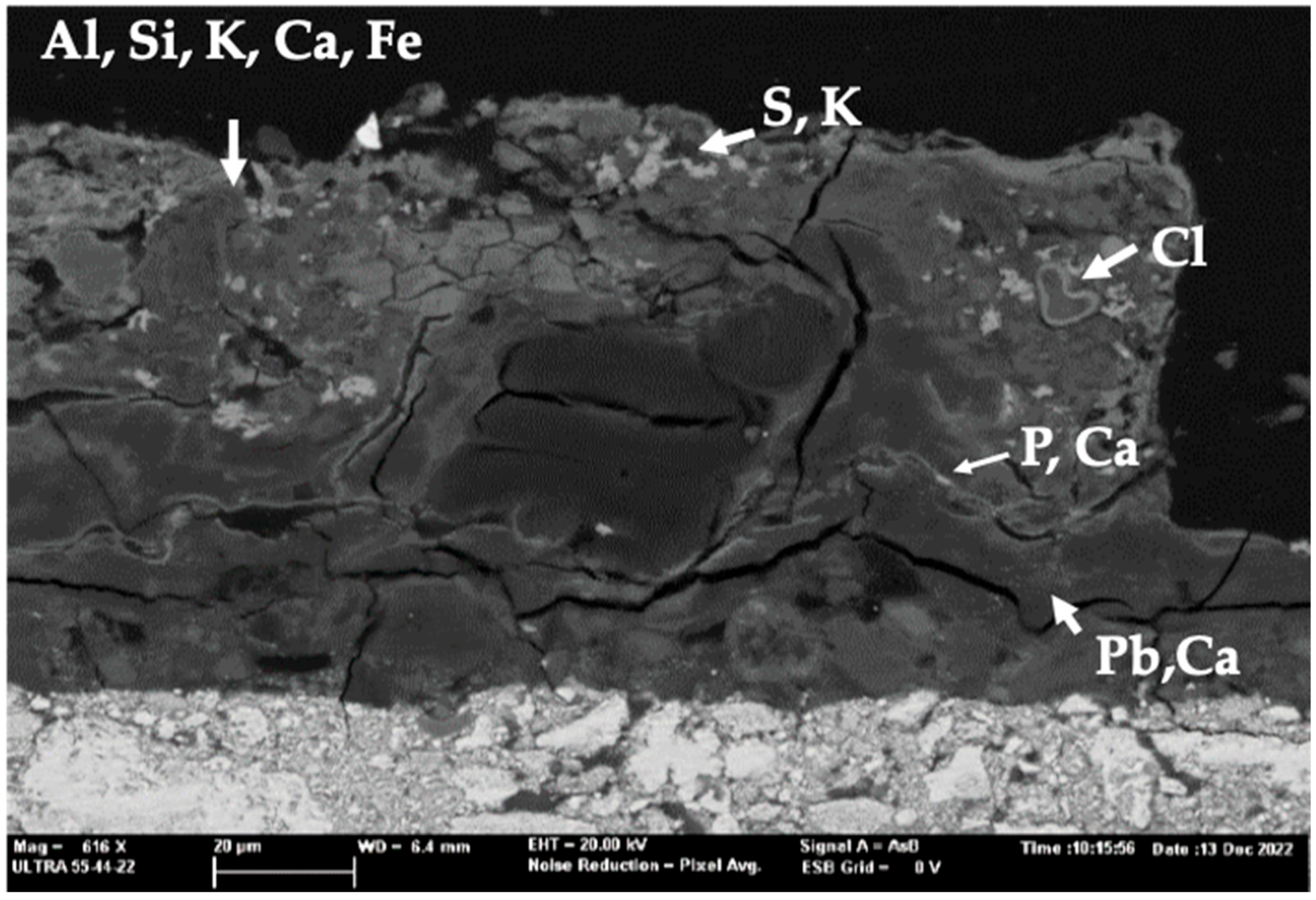


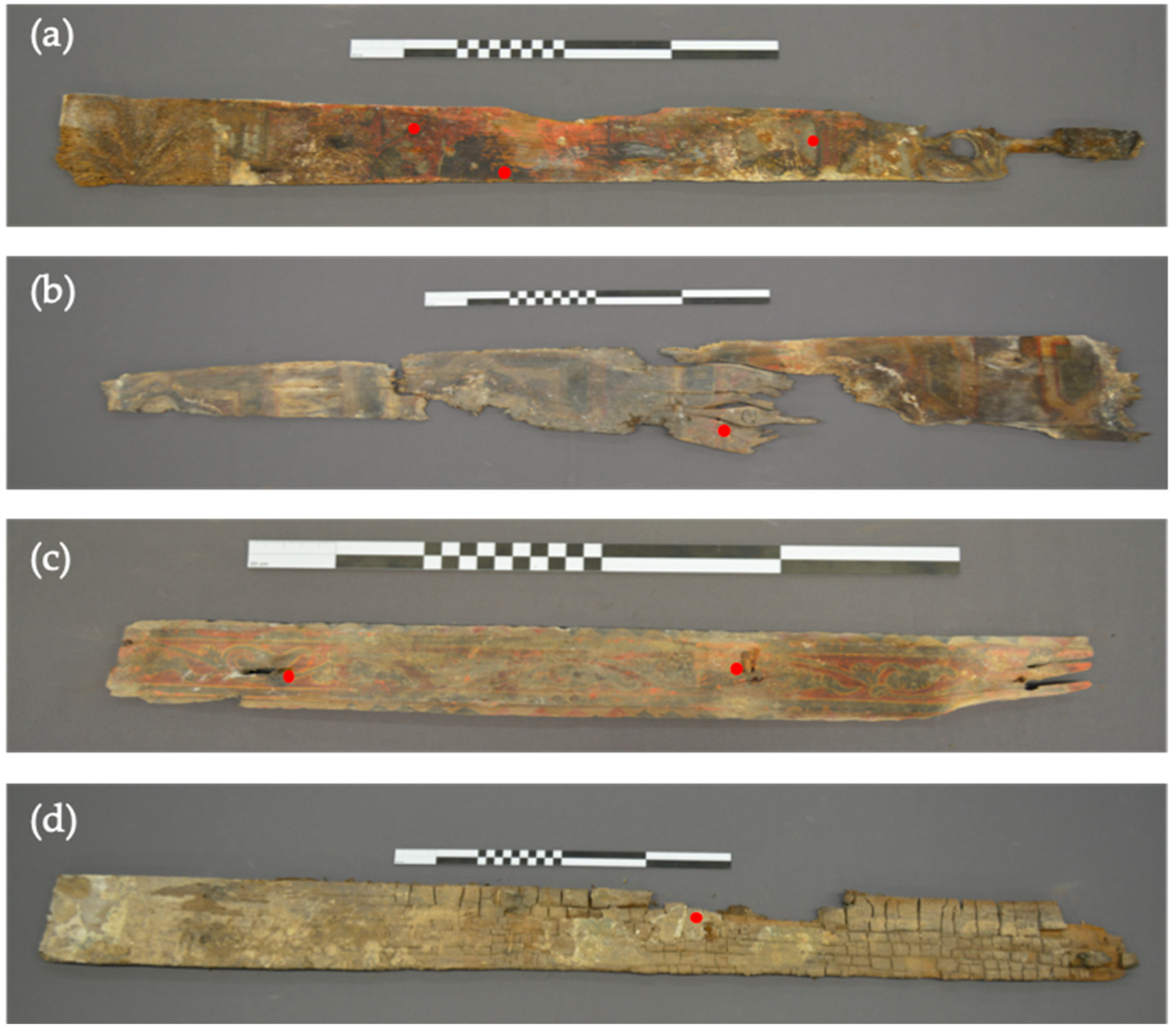
| Sample | Strata Distribution (Thickness 1, μm) | Main Compounds Identified | Techniques Employed for the Characterization |
|---|---|---|---|
| C-2 | 1. Altered protective coating (53) | Ca, Pb-carboxylates, Ca, Pb-oxalates, corrosion products and soil minerals | Optical microscopy FTIR spectroscopy FESEM-EDX 2 AFM-NI 3 |
| 2. Paint layer (20) | Cinnabar, proteinaceous medium | ||
| 3. Upper ground layer (40) | Gypsum with lead white, proteinaceous medium | ||
| 4. Inner ground layer (>80) | Gypsum with impurities, proteinaceous medium | ||
| C-4 | Surface: altered upper coating layer (31) | Ca, Pb-carboxylates, Ca, Pb-oxalates, gypsum, corrosion products and soil minerals | Optical microscopy FTIR spectroscopy FESEM-EDX GC-MS |
| 1. Lower coating (19) | n.i. 4 | ||
| 2. White paint layer (45) | Lead white, proteinaceous medium | ||
| 3. Thin organic layer (8) | n.i. | ||
| 4. Red paint layer (29) | Cinnabar, proteinaceous medium | ||
| 5.White ground (120) | Gypsum, proteinaceous medium | ||
| C-5 | Surface: alteration layer | Ca-carboxylates, Ca-oxalates, gypsum, corrosion products and soil minerals | Optical microscopy FTIR spectroscopy FESEM-EDX |
| 1. Yellow paint layer | Orpiment, proteinaceous medium | ||
| 2. Red paint layer (30) | Cinnabar, proteinaceous medium | ||
| 3. Wood support | Wood with gypsum infiltrated in the cells | ||
| D-1 | Surface: alteration layer | Ca-carboxylates, Ca-oxalates, gypsum, corrosion products and soil minerals, fungi | Optical microscopy FTIR spectroscopy FESEM-EDX |
| 1. Yellow paint layer (10) | Orpiment, proteinaceous medium | ||
| 2. Blue paint layer (50) | Indigo, lead white, proteinaceous medium | ||
| 3. Wood support | Wood with gypsum infiltrated in the cells | ||
| F-1 | Surface: alteration layer | Optical microscopy FTIR spectroscopy μRaman spectroscopy FESEM-EDX FIB-FESEM-EDX | |
| 1. Protective coating (9) | Ca, Pb-carboxylates, Ca, Pb-oxalates gypsum, corrosion products and soil minerals, fungi | ||
| 2. White paint layer (15) | Lead white, proteinaceous medium | ||
| 3. Blue paint layer (20) | Indigo, lead white, proteinaceous medium | ||
| 4. Red paint layer (28) | Cinnabar, proteinaceous medium | ||
| 5. White ground 5 | Gypsum, proteinaceous medium | ||
| F-4 | Surface: alteration layer | Ca, Pb-carboxylates, Ca, Pb-oxalates gypsum, corrosion products and soil minerals | Optical microscopy FTIR spectroscopy FESEM-EDX |
| 1. Blue-white paint layer (77) | Indigo, lead white, proteinaceous medium | ||
| 2. Wood support | Wood with gypsum infiltrated in the cells | ||
| J-2 | Surface: alteration materials | Ca, Cu, Pb-carboxylates, Ca, Cu, Pb-oxalates, gypsum, corrosion products and soil minerals | Optical microscopy FTIR spectroscopy FESEM-EDX |
| 1. Blue paint layer (25) | Azurite, lead white, proteinaceous medium | ||
| 2. Metal leaf (25) | Tin | ||
| 3. Altered metal layer (12–37) | Tin oxide | ||
| 4. Ground (>300) | Gypsum, proteinaceous medium | ||
| J-3 | Surface: alteration materials | Ca, Cu, Pb-carboxylates, Ca, Cu, Pb-oxalates, gypsum | Optical microscopy |
| 1. Blue paint layer (25) | Azurite, proteinaceous medium | ||
| 2. White paint layer (4) | Lead white, proteinaceous medium | FTIR spectroscopy | |
| 3. Organic layer (12) | n.i. | FESEM-EDX | |
| 4. Ground (>190) | Gypsum, proteinaceous medium | ||
| J-4 | Surface: alteration materials | Ca, Cu, Pb-carboxylates, Ca, Cu, Pb-oxalates, gypsum, corrosion products and soil minerals | Optical microscopy FTIR spectroscopy FESEM-EDX FIB-FESEM-EDX |
| 1. Organic coating layer (20) | n.i. | ||
| 2. Metal foil | Silver foil, silver sulfide | ||
| 3. Ground | Gypsum, proteinaceous medium | ||
| K-4 | 1. Altered coating layer | Ca, Cu-carboxylates, Ca, Cu-oxalates, gypsum, corrosion products and soil minerals, fungi | Optical microscopy FTIR spectroscopy μRaman spectroscopy FESEM-EDX FIB-FESEM-EDX |
| 2. Blue paint layer (40) | Azurite, proteinaceous medium | ||
| 3. Organic layer (15) | n.i. | ||
| 4. Ground (>650) | Gypsum, proteinaceous medium |
| Analytical IR Band (cm−1); (Assignment) 1 | Compound | Samples |
|---|---|---|
| 3484, 3398 (-OH stretch); 1682, 1619 (-OH deformation); 1095 (Sulfate ν3 stretch); 667, 594 (Sulfate ν4 deformation) | Gypsum | C-2G 2, C-4, C-4G, C-5, F-4, F-4G, J-2G, J-3, J-3G, J-4, J-4G, K-4, K-4G |
| 1390 (Carbonate ν3 stretch); 871 (Carbonate ν2 deformation); 710 (Carbonate ν4 deformation) | Calcite | C-2, C-2G, C-5, D-1, F-1, F-4G, J-2, J-2G, K-4 |
| 1439, 1399 (Carbonate ν3 stretch); 876 (Carbonate ν2 deformation); 728 (Carbonate ν4 deformation) | Dolomite | C-4G, F-1, F-4 |
| 3600 (-OH stretch); 1140 (Si-O-Si stretch); 1040-998 (Si-O stretch); 790, 773 (Si-O symmetric stretch) | Clayey minerals | C-4, C-5, D-1, F-1, F-4 |
| 3430(-OH stretch); 1494,1461, 1402 (Carbonate ν3 stretch); 830, 815 (Carbonate ν2 deformation); 771, 746 (Carbonate ν4 deformation) | Azurite | J-2, J-3, K-4 |
| 2952 sh3, 2922, 2870 sh, 2852 (-CH2, -CH3 stretch); 1741 (-C=O stretch); 1658, 1651, 1645, 1633, 1627 (α-helix, random coil, β-sheet conformations in amide I), 1532, 1537, 1518 (amide II) | Egg yolk | C-2, C-4, C-5, F-1, F-4, J-2, J-3, K-4 |
| 2940, 2880 (-CH2, -CH3 stretch); 1651, 1643, 1629 (α-helix, random coil, β-sheet conformations in amide I), 1534, 1510 (amide II) | Animal glue | C-2G, C4-G, C-5, D-1 |
| 1660 (Cu) 1643 (Pb) 1620 (Ca) (-COO asymmetric stretch); 1365 (Cu), 1360, 1321 (Pb), 1321 (Ca) (-COO symmetric stretch), 779 δwagging (-COO) | Ca, Pb, Cu-oxalate | C-2, C-2G, C-4, C4-G, C-5, D-1, F-1, F-4, J-2, J-3, J-3G, J-4, K-4 |
| 1584 (Cu), 1577 (Ca), 1541 (Pb), 1539 (Ca), 1517 (Ca) (-C=O stretch in carboxylate group) | Ca, Pb and Cu-carboxylates (palmitate, stearate, azelate) | C-2, C-2G, C-4, C4-G, C-5, D-1, F-1, F-4, F-4G, J-2, J-2G, J-3 |
| 1590-1500 b4 (-C=O stretch in carboxylate group) | Ionomeric phase | C-2, C-4, C-5, D-1, F-1, F-4, J-2, J-3 |
| 1560 (-C=O stretch in carboxylate group) | Ca-Aspargate and Ca-Glutamate | C-2, C-4, C-5, D-1, F-1, F-4, J-2, J-3 |
| 2550 Cysteine ν(CN), 1710–1716 Aspargic and glutamic acid ν(C=O), 1495–1510 Tyrosine (Tyr–OH), (Tyr–O−), ν(CC), δ(CH), Triptophane, ν(CN), δ(CH), δ(NH), Trp, ν(CC), δ(CH), Phe, ν(CCring) | Amino acid residues of proteins | C-2, C-4, C-5, D-1, F-1, F-4, J-2, J-3 |
| Amino Acid | Bovine Gelatin | Porcine Gelatin | Sample C-4 |
|---|---|---|---|
| Alanine | 8.64 | 11.78 | 9.97 |
| Glycine | 29.36 | 40.05 | 29.33 |
| Valine | 2.59 | 2.71 | 11.6 |
| Leucine | 3.80 | 4.71 | 16.3 |
| Isoleucine | 1.12 | 0.82 | n.d. 1 |
| Proline | 21.59 | 24.73 | 25.3 |
| Threonine | 1.04 | 0.35 | n.d. |
| Serine | 1.12 | 0.00 | n.d. |
| Glutamic acid | 3.45 | 0.82 | n.d. |
| Aspartic acid | 2.59 | 2.71 | n.d. |
| Methionine | 0.95 | 0.47 | n.d. |
| Hydroxyproline | 13.82 | 4.71 | 8.3 |
| Phenylalanine | 6.04 | 5.06 | n.d. |
| Lysine | 3.45 | 1.06 | n.d. |
| Tyrosine | 0.43 | 0.00 | n.d. |
Disclaimer/Publisher’s Note: The statements, opinions and data contained in all publications are solely those of the individual author(s) and contributor(s) and not of MDPI and/or the editor(s). MDPI and/or the editor(s) disclaim responsibility for any injury to people or property resulting from any ideas, methods, instructions or products referred to in the content. |
© 2023 by the authors. Licensee MDPI, Basel, Switzerland. This article is an open access article distributed under the terms and conditions of the Creative Commons Attribution (CC BY) license (https://creativecommons.org/licenses/by/4.0/).
Share and Cite
Álvarez-Romero, C.; García-Bueno, A.; López-Martínez, T.; Turatti-Guerrero, R.; Montoya, N.; Doménech-Carbó, M.T. New Insights into the Medieval Hispano-Muslim Panel Painting: The Alfarje Found in a Balearic Casal (Spain). Molecules 2023, 28, 1235. https://doi.org/10.3390/molecules28031235
Álvarez-Romero C, García-Bueno A, López-Martínez T, Turatti-Guerrero R, Montoya N, Doménech-Carbó MT. New Insights into the Medieval Hispano-Muslim Panel Painting: The Alfarje Found in a Balearic Casal (Spain). Molecules. 2023; 28(3):1235. https://doi.org/10.3390/molecules28031235
Chicago/Turabian StyleÁlvarez-Romero, Carla, Ana García-Bueno, Teresa López-Martínez, Rafael Turatti-Guerrero, Noemí Montoya, and María Teresa Doménech-Carbó. 2023. "New Insights into the Medieval Hispano-Muslim Panel Painting: The Alfarje Found in a Balearic Casal (Spain)" Molecules 28, no. 3: 1235. https://doi.org/10.3390/molecules28031235
APA StyleÁlvarez-Romero, C., García-Bueno, A., López-Martínez, T., Turatti-Guerrero, R., Montoya, N., & Doménech-Carbó, M. T. (2023). New Insights into the Medieval Hispano-Muslim Panel Painting: The Alfarje Found in a Balearic Casal (Spain). Molecules, 28(3), 1235. https://doi.org/10.3390/molecules28031235







